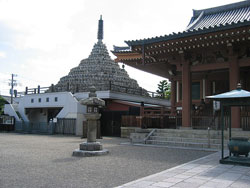This temple is the headquarters of the 'Risshu' sect of Buddhism, and was built in 991. It is famous for its 'Mibu kyogen' performance in late April. It is also known for its connection to the 'shinsen-gumi' (a samurai group who patrolled Kyoto in the late Edo period).

History
According to tradition Mibu-dera Temple was established by the order of Emperor SHOMU (r. 724-749) for the Chinese monk known in Japan as GANJIN (JIANZHEN in Chinese; 688-763). Monk GANJIN introduced the Ritsu Sect of Buddhism from China into Japan. He is most famous for persisting in his attempts to reach Japan, despite many disastrous failures by ship, finally making it when he was already in his 80's and blind. The most famous temple of the Ritsu Sect is Toshodaiji in Nara, founded by GANJIN.
The actual founder of Mibu-dera Temple was KAIKEN, a monk of another temple in Mibu district, who erected a chapel for the Bodhisattva Jizo at the site of GANJIN'S former residence in 991. This chapel, just east of the present location, was completed in 1005. The enshrined statue was carved by JOCHO (?-1057), the best sculptor of Buddhist images in Kyoto during the Heian Period. The only surviving work of JOCHO is housed in Byodo'in Temple in Uji.
In 1077 the Emperor SHIRAKAWA (r.1073-87) awarded Mibu-dera Temple the status of Chokuganji (a temple where prayers were offered for the well-being of the Imperial Family and the tranquility of the country).
At the beginning of the Kamakura Period (1185 - 1392), TAIRA no MUNEHIRA , reestablished Mibu-dera Temple at its present location after it and JOCHO's Jizo were destroyed by fire in 1257.
DOGYO, also known as Engaku-juman Shonin, collected funds to rebuild Mibu-dera Temple. DOGYO sponsored the yuzu-dainenbutsu-e ceremonial gatherings at Mibu-dera Temple, as well as at Hokongo'in and Seiryo-ji Temples. At these meetings, worshipers would chant the name of the Amida Buddha in a loud voice. Mibu-dera Kyogen Pantomime evolved from DOGYO's yuzu-dainenbutsu-e ceremonial gatherings.
By the Muromachi period (1338-1573) the Jizo, known as one of the Roku (six) Jizo was an object of worship and drew many followers. By the Edo Period (1615-1865) Mibu-dera Temple was known as the "Temple of Plays" and can be found in guide books of the period, making it popular all over Japan.
The entire temple was again destroyed by fire in 1788. When rebuilt, the Main Hall faced east as it does today and the Kyogen-do (stage) was built as a separate structure just north of the main hall. The next restoration was in 1825. Fire struck again in 1962 burning down the Main Hall. It was rebuilt in 1967 with contributions from devotees. The present Jizo (Important Curltural Treasure) came from Toshodaiji Temple.
The Crest of Mibu-dera Temple is the cherry flower.
Address
Bojo-dori Bukkouji Kita-iru, Nakagyo-ku, Kyoto City.
Tel: 075-841-3381



